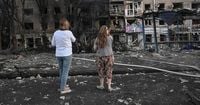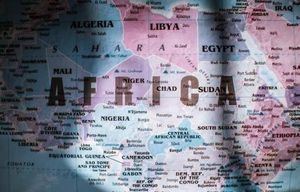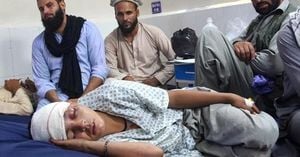Russia unleashed a massive aerial assault on southern Ukraine in the early hours of August 30, 2025, striking residential neighborhoods, crippling infrastructure, and underscoring the ongoing volatility of a war now entering its fourth year. The attack—described by Ukrainian officials as one of the largest of its kind—came just two days after a rare and deadly airstrike on central Kyiv killed 23 people, including children, and damaged European Union diplomatic offices, according to multiple reports from the Associated Press and regional authorities.
In Zaporizhzhia, a region that has seen repeated bombardment since Russia’s full-scale invasion in 2022, the overnight barrage left one civilian dead and nearly 30 others wounded, among them several children, Governor Ivan Fedorov confirmed. A five-story residential building bore the brunt of the attack, with images released by the National Police of Ukraine showing twisted steel, shattered glass, and rescue teams pulling survivors from the rubble. Fires broke out at multiple industrial sites, and the blast wave damaged at least 14 high-rise buildings and over 40 private homes, leaving around 25,000 people without power, Fedorov added, as reported by Novaya Gazeta Europe.
The Ukrainian Air Force reported that Russia launched an astonishing 537 strike drones and decoys, along with 45 missiles, in the coordinated assault. Ukrainian air defenses responded with remarkable effectiveness, shooting down or neutralizing 510 drones and decoys and 38 missiles. Still, five missiles and 24 drones managed to strike seven locations, with falling debris affecting 21 areas, the Air Force said. The eastern Dnipropetrovsk region was also hit, damaging infrastructure in the cities of Dnipro and Pavlohrad, although, according to Governor Serhiy Lysak, no casualties were reported there.
President Volodymyr Zelenskyy, addressing the nation and the international community, decried the repeated attacks as evidence of Russia’s “utter disregard for words” and called for a more robust global response. “We saw the world’s response to the previous strike,” Zelenskyy said, referencing the deadly attack on Kyiv earlier in the week. “But now, as Russia once again shows its utter disregard for words, we count on real action. … This war won’t stop with political statements alone; real steps are needed. We expect action from the US, Europe, and the entire world.”
Thursday’s airstrike on Kyiv, which killed 23 people and damaged EU diplomatic offices, was one of the few times Russian drones and missiles have penetrated the heart of the Ukrainian capital since the start of the war. Children were among the dead, and search and rescue efforts continued for hours as emergency workers sifted through the debris. The attack came as U.S.-led efforts to broker peace between Ukraine and Russia appeared to be faltering, with both sides accusing each other of stalling negotiations.
Despite the escalation, the Kremlin stated on August 28 that Russia remained interested in continuing peace talks. However, Ukrainian President Zelenskyy expressed frustration with what he described as Russia’s lack of constructive engagement. Ukraine has accepted a U.S. proposal for a ceasefire and a meeting between Putin and Zelenskyy, but Moscow has raised objections, according to the Associated Press. Former U.S. President Donald Trump, who met separately with both Putin and Zelenskyy during a presidential summit in Alaska earlier in August, said he believed three-way talks would still happen but expressed less confidence about arranging bilateral talks, telling the Daily Caller, “That’s why I really thought we would have this done. I would have loved to have had it done.”
Meanwhile, the United States moved quickly to bolster Ukraine’s defensive capabilities. Hours after the August 30 attack, Washington approved an $825 million arms sale to Ukraine, which includes extended-range missiles and related equipment. The Biden administration’s move was widely seen as an effort to reassure Kyiv and signal to Moscow that Western support remains firm, even as diplomatic efforts stall.
On the battlefield, Russian forces have maintained what they describe as a “nonstop” offensive along nearly the entire 1,000-kilometer front line. General Valery Gerasimov, Russia’s chief of general staff, claimed that Moscow’s troops have taken more than 3,500 square kilometers of Ukrainian territory and captured 149 settlements since March 2025. Ukrainian military officials confirmed that Russian troops had pressed into the southeastern Dnipropetrovsk region, marking an incursion into an eighth Ukrainian province. The Associated Press noted that these claims could not be independently verified, but the intensity of fighting has been widely acknowledged.
In a parallel campaign, Ukraine has intensified strikes on Russian oil refineries, targeting facilities that it says are fueling Moscow’s war effort. The Ukrainian General Staff reported overnight hits on refineries in the Krasnodar region near occupied Crimea and in the Samara region further northeast. Regional Russian authorities confirmed that falling drone debris sparked a fire at the Krasnodar refinery, damaging one processing unit but causing no casualties. The facility produces about 3 million tons annually of petroleum products such as gasoline, diesel, and aviation fuel. A separate drone strike caused a fire at the Syzran Oil Refinery in Samara province. These attacks have contributed to gasoline shortages in some Russian regions, with motorists facing long lines and officials resorting to rationing or halting sales altogether. In response, Russia imposed a full ban on gasoline exports until September 30 and a partial ban for traders and intermediaries until October 31, as reported by the Associated Press. Analysts expect the crisis to ease by late September as demand drops and summer refinery maintenance concludes, but the shortages have exposed a vulnerability on the Russian home front that Ukraine may seek to exploit further as drone warfare evolves.
Amid the chaos of war, tragedy struck the Ukrainian political sphere as well. On August 30, Andriy Parubiy, Ukraine’s former parliament speaker and a prominent pro-Western politician, was shot dead in the city of Lviv. President Zelenskyy condemned the “terrible murder” and vowed to open an investigation. Parubiy, 54, had been a key figure in Ukraine’s Orange Revolution in 2004 and led volunteer self-defense units during the 2014 Maidan protests that ousted pro-Russian President Viktor Yanukovych. He served as parliament speaker from 2016 to 2019. Little is known about the perpetrator or the motive behind the killing, but the assassination has sent shockwaves through Ukrainian society at a time of national crisis.
As the war grinds on, the European Union is weighing new measures to make Russia pay for its invasion. European Commission President Ursula von der Leyen announced that the EU is advancing toward seizing frozen Russian assets to provide reparations to Ukraine, though some member states have voiced concerns about the financial and legal implications of such a move. Over two days in Copenhagen, EU foreign and defense ministers discussed sanctions, increased defense supplies to Kyiv, postwar security guarantees, and Ukraine’s prospects for joining the 27-nation bloc.
With no clear end to the conflict in sight and both sides digging in, the fate of Ukraine—and the broader European security order—hangs in the balance. The latest attacks underscore the high stakes, the human cost, and the urgent need for meaningful action beyond words.






